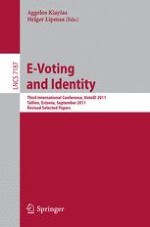2012 | Book
E-Voting and Identity
Third International Conference, VoteID 2011, Tallinn, Estonia, September 28-30, 2011, Revised Selected Papers
Editors: Aggelos Kiayias, Helger Lipmaa
Publisher: Springer Berlin Heidelberg
Book Series : Lecture Notes in Computer Science
